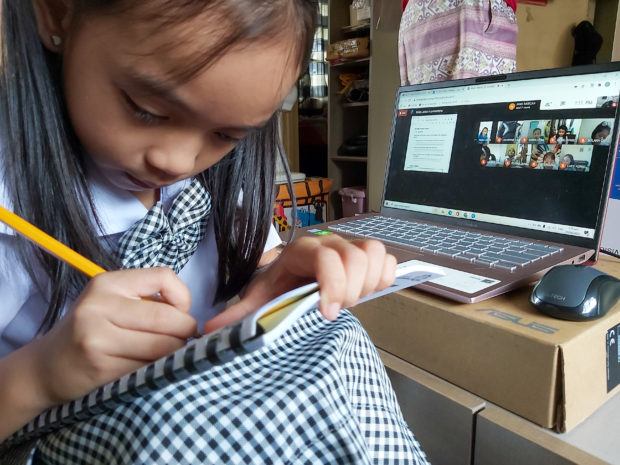Enrolment drops in Central, Eastern Visayas as classes in public school start

(FILE PHOTO) ‘BLENDED LEARNING’ From her home in Calamba City, Laguna province, a Grade 2 pupil dressed in her uniform takes down notes as she attends online class, conducted by the private school in Makati City where she is enrolled. —CHRIS QUINTANA
TACLOBAN CITY –As public schools started its blended learning on Monday–its second year since the pandemic began in 2020–the number of enrollees dropped in Central and Eastern Visayas.
In Eastern Visayas, at least 954,073 students were enrolled for the school year –lower than the 1.2 million last year, said Jazmin Calzita, regional information officer of the Department of Education (DepEd).
At least 1.9 million students were enrolled in Central Visayas, lower than last year’s 2.1 million.
But education officials of both regions were optimistic that the number of enrollees would go up since enrollment would continue until the end of September.
“We expect the number of enrollees this year to exceed that of last year because our enrollment continues until Sept. 30,” said DepEd-Central Visayas Director Salustiano Jimenez.
Like in 2020, students in the regions would use blended learning methods — either modules or through online classes depending on the capability of both the students and the teachers.
Jimenez said that the modules’ budget was downloaded from its central office to the regional office and then to the schools division offices.
In a media interview, Jimenez said they need the budget for other school needs such as alcohol, face masks, and face shields for its teaching and non-teaching personnel.
Central Visayas has about 82,000 teaching and non-teaching personnel. Of the number around 79,000 are teachers.
In Bohol, parents and guardians would claim the printed modules on different days: Monday for Grade 7 students; Tuesday for Grades 8 and 12; Wednesday for Grade 9; Thursday for Grade 10; and Friday for Grade 11.
Parents would return the modules after a week and claim the second set of modules.
Maurine Castaño, principal of the Dr. Cecilio Putong National High School, said the school introduced innovative ways to “level up.”
She said they officially launched the digital modular distance learning.
With the use of the Internet, teachers and students can access the learners’ management system.
Once students are sure of their answers, they have to upload it to the learner’s management system.
“Will our enrollees for the digital modular distance learning survive until the end of school year? I hope they will. But we are also preparing ourselves that some may migrate to usual printed modular distance learning. But we will accommodate them if there is a sudden shift of modality. For as long as they finish the school year with a good performance,” Castaño said.
In Eastern Visayas, Calzita said they would adopt more measures to ensure that students will still have quality education like the strengthening of the radio and television-based instructions.
Negros Occidental Gov. Eugenio Jose Lacson said that when there was a need to go online amid the COVID-19 pandemic, the educational system had no choice but to step up.
“I would like to acknowledge and extend my utmost appreciation to all our teaching and non-teaching personnel, and to everyone who took the cudgels to ensure that education shall continue for the hundreds of thousands of Negrense students,” he said.
Lacson also urged the students to take their studies seriously. “Do your best, remember that the future of Negros Occidental is in your hands. Please make us proud,” said. With reports from Joey Gabieta, Leo Udtohan, Carla Gomez, and Ador Mayol, Inquirer Visayas